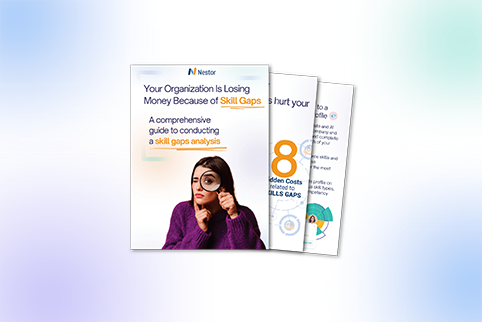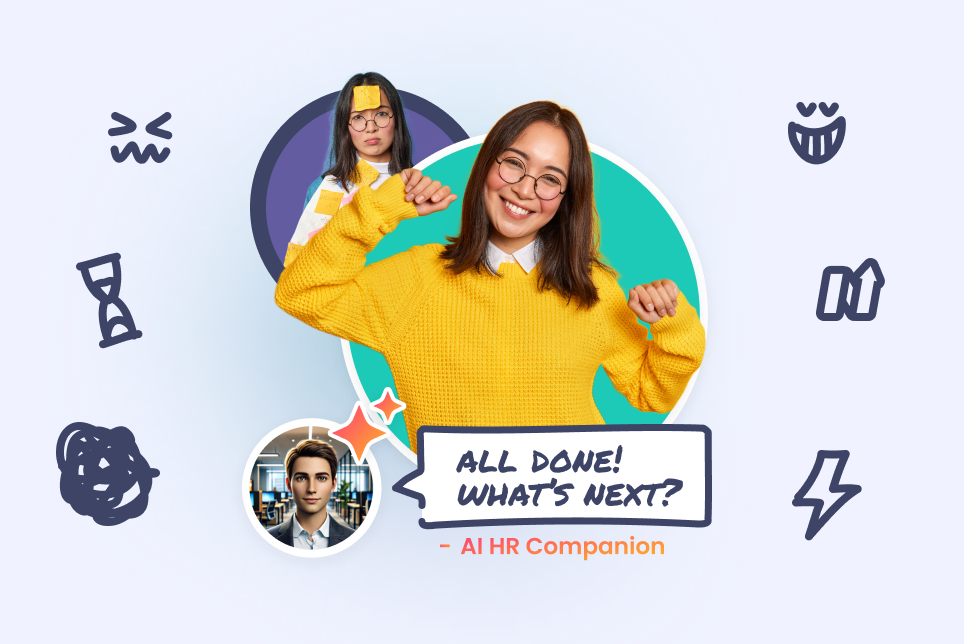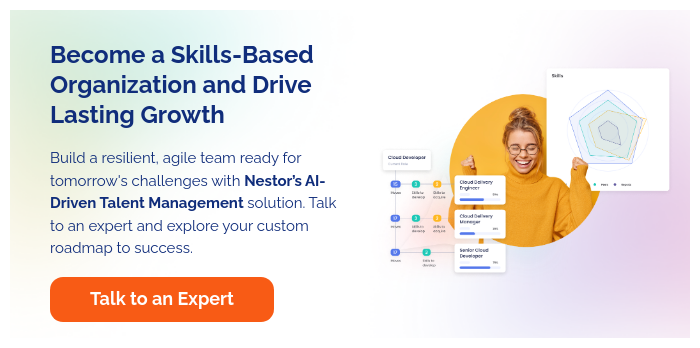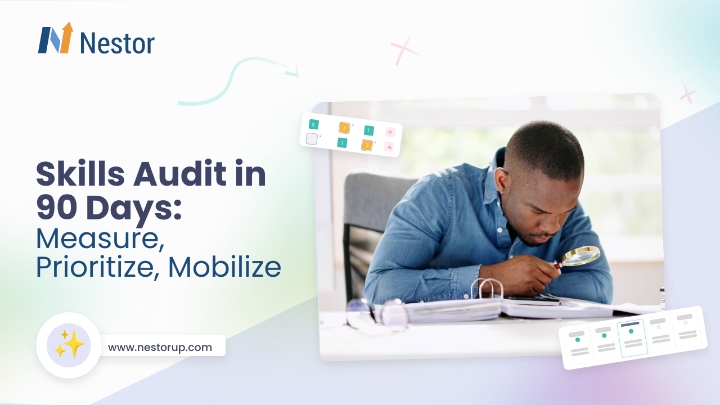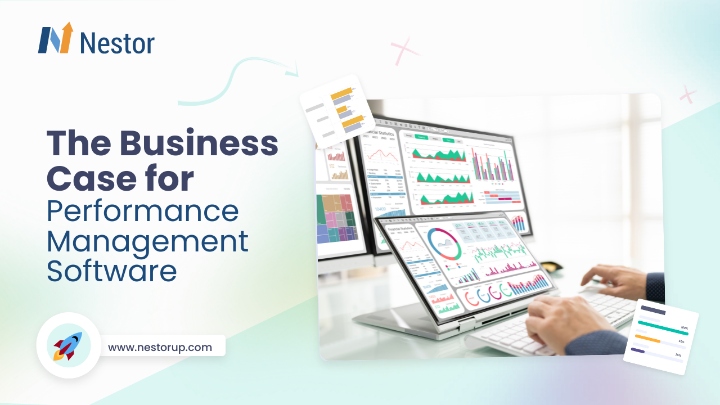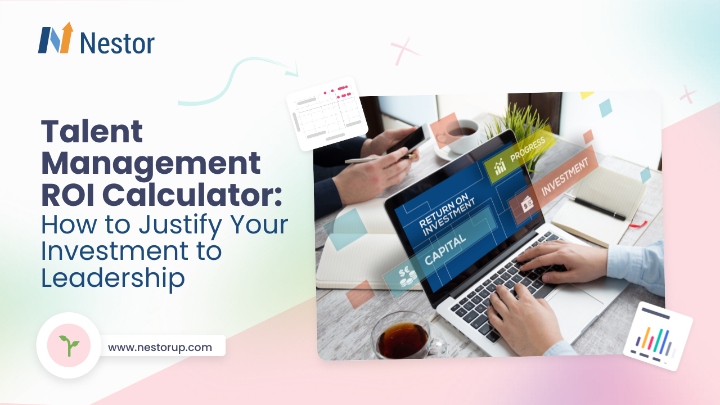Talent Management System 101: Everything You Need to Know
31 min read

Contents
In any organization, people are the heartbeat. But keeping track of their journey from recruitment to development and beyond, isn’t always as simple as it sounds. That’s where a Talent Management System (TMS) comes in. What is a Talent Management System? It’s a powerful software solution designed to help companies manage and optimize their workforce, from the first touchpoint of recruitment to career progression, all the way to succession planning.
But calling it just a software solution doesn’t really do it justice. It’s more like a digital map of your organization’s talent landscape, updated in real-time. Not only does it tell you who’s on your team, it shows you where they’re strong, where they want to go, and what might be missing to get them there.
That visibility? It matters more than ever. In fact, 70% of business leaders say their organizations are facing critical skills gaps that limit growth and innovation. Without visibility into skills and development opportunities, those gaps only widen.
Now, you might be wondering, “Why do I need a Talent Management System?”
Well, the answer is simple: effective talent management directly impacts a company’s bottom line. It helps align your people with your organizational goals. It ensures you’re developing the skills that are critical for success, and supports leaders in making data-driven decisions.
People don’t stay in the same role for ten years anymore. Skills evolve. Markets shift. Expectations rise. And the companies that thrive are the ones that can quickly spot potential, adapt learning paths, and connect individual growth to business strategy. All of this without burning out their HR teams in the process.
That’s the promise of a Talent Management System. But how exactly does it work? What are the must-have features, and how do they impact daily operations or long-term planning?
Let’s break it down, starting with the foundational elements that every modern TMS should cover.
Core Features of a Talent Management System
Now that we’ve got a solid idea of what a Talent Management System (TMS) is, let’s dive into the core features that make it an indispensable tool for organizations. And while each TMS will vary depending on the provider and the organization’s needs, most systems provide a comprehensive suite of tools that streamline and optimize various HR functions, from recruitment to succession planning.
But not every TMS will include all of these features. Some may provide a more specialized focus depending on the needs of the business. For example, platforms like Nestor include AI-powered skills management, personalized development plans, and advanced performance tracking. A different TMS may not offer such robust AI tools or the talent marketplace functionality.
With that said, let’s take a closer look at the core features most TMS platforms offer:
1. Workforce Planning: Aligning Talent with Strategy
- Strategic Alignment: A TMS allows HR teams to align talent strategies with business goals. This involves working closely with leadership teams to understand long-term business objectives and ensuring that the right talent is in place to support these goals.
- Forecasting Needs: It helps predict future workforce needs, ensuring that the company is prepared to meet those demands. This might involve identifying skill gaps and forecasting which roles will be needed as the business evolves.
2. Recruitment: Attracting the Right Talent
- Sourcing Talent: A TMS helps organizations cast a wide net by sourcing talent globally. With features like integrated job boards and applicant tracking systems, HR teams can manage the entire recruitment process from posting jobs to screening and hiring.
- Candidate Nurturing: Beyond just hiring, a TMS enables HR to nurture candidates throughout the hiring process. It’s not just about filling positions; it’s about building relationships and keeping top candidates engaged, even if they’re not hired right away.
3. Onboarding: Setting Employees Up for Success
- Streamlined Onboarding: A TMS enhances the new hire experience by providing a dedicated portal where employees can complete all necessary paperwork, access training, and get familiar with company culture before they even step foot in the office (or log in from home).
- Employee Engagement: Ensuring employees feel welcomed and prepared is critical. A TMS optimizes onboarding by automating key processes and offering a structured, engaging experience for new hires.
4. Performance Management: Driving Continuous Improvement
- Real-Time Feedback: Traditional performance reviews are often too late to make a real difference. A TMS focuses on continuous feedback and performance tracking. It helps employees understand how their goals align with the company’s mission, providing ongoing support to keep them on track.
- Goal Alignment (OKRs, KPIs): A TMS ensures that individual performance goals are in line with the company’s strategic objectives, allowing for better alignment and performance tracking.
- 360-Degree Feedback: By incorporating feedback from peers, managers, and even self-assessments, a TMS provides a comprehensive view of employee performance. This helps identify both strengths and areas for improvement.
5. Learning & Development: Fostering Growth
- Personalized Learning Paths: A TMS offers tailored learning opportunities for employees based on their career aspirations and current skills. The system tracks progress and suggests new courses or skill-building exercises.
- Skill Gap Analysis: It helps identify areas where employees need additional training, guiding HR teams in implementing upskilling and reskilling programs to meet business needs. And this matters more than ever now, as 39% of workers’ core skills are expected to change by 2030, according to the World Economic Forum. A proactive learning strategy is no longer optional.
- Career Development: Beyond training, a TMS also helps employees map out their career paths, providing clear guidance on how to move forward within the organization.
6. Succession Planning: Preparing for the Future
- Leadership Development: A key function of a TMS is identifying high-potential employees and providing them with the tools and opportunities they need to grow into leadership roles.
- Continuity & Risk Management: By planning for leadership succession, a TMS helps mitigate the risks associated with turnover and ensures that critical roles are filled quickly, minimizing disruptions to business operations.
7. Compensation & Rewards: Recognizing Performance
- Compensation Planning: A TMS can integrate with payroll systems to provide accurate compensation tracking and ensure pay equity across the organization. It helps HR teams design competitive compensation structures that reward high performers.
- Employee Rewards & Recognition: It also offers tools for recognizing and rewarding employees for their contributions, which boosts morale and helps retain top talent.
8. Analytics & Reporting: Data-Driven Decisions
- Actionable Insights: The true power of a TMS lies in its ability to generate data-driven insights. HR teams can use these analytics to track everything from recruitment effectiveness to performance trends, providing actionable data that drives smarter decision-making.
- Customizable Dashboards: Whether you’re tracking employee engagement or monitoring skill development, a TMS provides customizable reports and dashboards to keep HR teams in the know.
Wrapping It All Together
By integrating all these elements, a Talent Management System creates a seamless, data-driven approach to managing your most important asset; your people. It ensures that recruitment, performance, learning, and development are aligned with business goals, creating a more efficient, engaged, and productive workforce.
A TMS doesn’t just help with day-to-day HR tasks. It transforms the way an organization attracts, develops, and retains talent. From improving employee satisfaction to enhancing business performance, it’s a tool that aligns talent strategies with business needs, allowing companies to not just survive but thrive in today’s competitive environment.
Next up, let’s look at the specific benefits of implementing a TMS and how it helps businesses overcome common HR challenges.
Benefits of Implementing a Talent Management System
Now that we’ve explored the core features of a Talent Management System (TMS), let’s dive into the tangible benefits of adopting one for your organization. Implementing a TMS isn’t just about upgrading software or automating HR tasks. It’s about optimizing your entire talent strategy, enhancing employee engagement, and boosting organizational performance. The benefits are far-reaching, impacting HR teams, employees, and the business as a whole.
Streamlined HR Processes: Efficiency at Its Best
- Automation of Repetitive Tasks: A TMS reduces the burden of manual, repetitive tasks, like processing job applications, scheduling interviews, or compiling performance reviews. By automating these workflows, HR teams can spend less time on administrative work and more on strategic initiatives that drive business success.
- Centralized Data: With all employee data in one place, from recruitment and onboarding to performance and compensation, HR teams can access real-time insights, ensuring faster decision-making. No more sifting through paper files or disparate systems. Everything is integrated and at your fingertips.
Improved Employee Engagement & Retention
- Continuous Feedback Loops: A TMS encourages ongoing feedback, which plays a key role in employee engagement. When employees receive consistent feedback on their performance, they feel valued and can continuously improve. This proactive feedback helps identify issues early, preventing disengagement and boosting job satisfaction.
- Personalized Career Development: By providing employees with tailored learning paths and career growth opportunities, a TMS makes it easier to align their personal goals with the company’s vision. Employees who see clear career development opportunities are more likely to stay and grow with the organization. Especially when the cost of turnover can range from 50% to 200% of an employee’s annual salary, retaining top talent is both a strategic and financial imperative.
- Recognition & Rewards: Most TMS platforms come with features for recognizing and rewarding employees, which further drives engagement. A simple thank you, a performance bonus, or a public shout-out can go a long way in making employees feel appreciated and motivated.
Better Recruitment and Onboarding
- Faster, More Efficient Hiring: With tools for candidate screening, tracking, and communication, a TMS speeds up the recruitment process. HR teams can source candidates more effectively, screen them quickly, and maintain a constant flow of qualified talent, reducing time-to-hire. That efficiency can have a real financial impact: the average cost per hire is approximately $4,700, making smarter recruitment workflows more than just a convenience.
- Seamless Onboarding Experience: First impressions matter, and a TMS helps create a smooth onboarding process. New hires are welcomed into the company with all the tools and resources they need to succeed right from the start. This reduces turnover in the critical first few months and sets the tone for their entire career with the company.
Data-Driven Decision Making
- Informed Talent Strategy: A TMS collects and analyzes data across multiple HR functions: recruitment, performance, training, and more. This data is invaluable for shaping HR strategies that align with business goals. For example, HR teams can identify trends in employee turnover, skill gaps, or engagement, allowing them to make proactive, informed decisions.
- Predictive Analytics: Advanced TMS platforms, especially those with AI capabilities, provide predictive analytics. These tools help HR teams anticipate future needs, such as skills shortages, leadership gaps, or upcoming performance issues, and take action before problems arise.
Enhanced Learning and Development Opportunities
- Tailored Training Programs: A TMS creates personalized learning and development plans based on individual skill gaps and career goals. Employees are empowered to grow in their current roles or prepare for future opportunities, improving overall productivity and job satisfaction.
- Tracking Progress: A TMS enables HR teams and employees to track progress toward development goals. With clear metrics in place, employees can see how their efforts are contributing to their professional growth and the company’s success.
Future-Proofing Your Organization
- Succession Planning: By identifying high-potential employees and tracking their progress, a TMS helps companies prepare for future leadership transitions. Instead of scrambling to fill leadership gaps when key employees leave, organizations can proactively develop talent to fill these critical roles.
- Agile Workforce Management: With the workforce constantly evolving, whether due to remote work, skill demands, or changing business needs, a TMS provides the agility necessary to adapt. The system’s ability to quickly identify skill gaps, track employee mobility, and offer personalized development plans ensures your organization is always ready for the future.
Improved Compliance and Risk Management
- Ensuring Legal Compliance: A Talent Management System ensures that your organization remains compliant with relevant labor laws, regulations, and industry standards. By automating tasks like compensation tracking, performance reviews, and documentation management, a TMS reduces the risk of human error and keeps you up to date with compliance requirements.
- Data Security: With employee data stored securely within the system, a TMS reduces the risk of data breaches or mishandling. It ensures that sensitive information like compensation details and performance reviews, is securely stored and only accessible by authorized personnel.
Challenges in Talent Management and How a Talent Management System Can Address Them
Talent management is complex. From recruitment to retention, performance tracking to skill development, organizations face numerous challenges in managing their workforce effectively.
Fortunately, a robust Talent Management System (TMS) can help organizations solve these obstacles head-on, providing tools to streamline processes, reduce inefficiencies, and ensure a better employee experience. Let’s look at some of the common challenges in talent management and how a TMS can help solve them.
Talent Shortages: Finding the Right People
The job market is competitive, and finding the right talent can often feel like searching for a needle in a haystack. The pressure to fill positions quickly can lead to rushed decisions and missed opportunities to hire top-tier candidates. Additionally, organizations may struggle to reach the right talent pools, which can lead to high recruitment costs and longer time-to-hire.
A TMS can make this process more efficient by streamlining the entire recruitment pipeline. With integrated tools for candidate sourcing, screening, and tracking, HR teams can save time and reduce manual work.
More importantly, an advanced TMS, especially one powered by AI, can match candidates to roles based on skills, experience, and company fit, ensuring better matches and a quicker hiring process. The system can even predict hiring needs based on business growth projections, making it easier to stay ahead of staffing demands.
High Turnover Rates: Retaining Top Talent
Employee turnover is costly, not just in terms of recruitment and training, but also in the lost productivity and morale that comes when employees leave. Organizations that struggle to retain their best talent risk falling behind competitors and losing valuable knowledge and skills.
A TMS can help reduce turnover by fostering better employee engagement. Continuous feedback and performance management tools allow managers to identify disengagement early and take action before it leads to resignation.
Additionally, a TMS offers personalized career development plans, which can keep employees motivated and focused on growth. When employees see that they have a clear path for advancement and that the company is invested in their development, they are more likely to stay.
Skills Gaps: Preparing for the Future
As industries evolve and technologies change, companies face the challenge of ensuring that their workforce is equipped with the right skills. Often, there is a gap between the skills employees currently have and the skills needed for future roles. This can lead to inefficiencies, delays in projects, or even missed business opportunities.
A TMS can help address this by offering skill gap analysis tools. By assessing employees’ current skills and comparing them with the company’s future needs, HR teams can identify areas for improvement.
With this information, the TMS can recommend tailored learning and development paths, ensuring that employees are continuously upskilled and ready for new challenges. This proactive approach to learning ensures that organizations remain competitive and that employees are prepared for both current and future roles.
Supporting this shift isn’t optional as 58% of L&D leaders report that accelerating skill gaps and delayed AI adoption are among their top concerns.** A TMS built for adaptability helps close this gap before it grows too wide.
Managing a Distributed Workforce: Remote and Hybrid Challenges
Managing remote and hybrid teams presents its own set of challenges. With employees working from different locations, maintaining consistent communication, monitoring performance, and fostering a cohesive company culture can be difficult.
A TMS can help by centralizing communication and performance tracking in one platform, making it easier for managers to stay connected with their teams. Whether through regular performance reviews, goal tracking, or even informal feedback loops, a TMS ensures that employees, no matter where they work, are aligned with organizational goals.
Additionally, many TMS platforms are cloud-based, meaning they can be accessed anywhere, allowing employees to engage with the system, track progress, and stay up to date with company initiatives.
Inconsistent Performance Reviews: Ensuring Fairness and Accuracy
Traditional performance reviews often come with biases and inconsistencies. They may be infrequent, subjective, or based on limited feedback, which makes it hard to get an accurate picture of an employee’s performance. As a result, employees may feel overlooked or unfairly assessed, which can impact their engagement and motivation.
A TMS transforms performance management by offering continuous feedback, 360-degree evaluations, and data-driven assessments. This shift ensures that performance reviews are consistent, based on real-time data, and aligned with company goals.
Managers can track employee progress over time and adjust development plans accordingly. With ongoing feedback and performance tracking, the review process becomes more transparent, fair, and focused on growth, helping employees improve and stay engaged.
Compliance and Reporting: Staying on the Right Side of the Law
Compliance is always top of mind for HR teams, but staying on top of changing labor laws, compensation regulations, and other compliance issues can be a challenge. Without the right tools, HR teams may find themselves struggling to ensure that all processes are compliant, leading to potential legal risks.
A TMS helps with compliance by automating many of the necessary processes, such as compensation tracking, performance evaluations, and employee records management. This ensures that all employee data is stored securely and can be easily accessed when needed for audits or reporting. The system can also flag potential compliance issues, allowing HR to address them proactively, which reduces the risk of legal complications down the road.
Choosing the Right Talent Management System for Your Organization
Choosing the right Talent Management System (TMS) can be daunting, but it doesn’t have to be. After all, this is a big decision, and it will play a huge role in shaping how your organization attracts, develops, and keeps top talent.
So, how do you pick the best TMS for your business? Let’s break it down in a straightforward way that makes the decision process clearer and less overwhelming.
1. Assess Your Needs: What Are You Really Looking For?
Before you even start looking at TMS options, take a moment to think about your organization’s unique needs. This isn’t about picking the trendiest platform or the one with the most bells and whistles; it’s about choosing something that will actually help you solve your HR challenges.
Start by asking yourself:
- What issues are you trying to address? Are you looking to streamline hiring, improve performance tracking, or boost employee engagement?
- What are your business goals? Do you need a system that can scale as your company grows or one that focuses on performance management?
- What does your workforce look like? Is it largely remote, hybrid, or in-person? Some TMS solutions cater better to remote teams, so knowing your setup will help narrow down your choices.
These questions will guide you toward a system that meets your specific needs, rather than just one that looks good on paper.
2. Scalability and Integration: Will It Grow With You?
A TMS should fit your business now and in the future. As your company expands, you’ll need a system that can keep up with increased complexity and employee numbers. Scalability is important.
Also, think about how well the TMS integrates with your existing tools. If you’re already using payroll software, performance tracking systems, or other HR platforms, you’ll want a TMS that can smoothly integrate with them. A seamless flow of data between systems will save you from unnecessary headaches down the line.
3. User Experience: How Easy Is It to Use the Talent Management System?
It doesn’t matter how great a TMS’s features are if no one in your organization knows how to use it. A good system should be simple, intuitive, and easy to navigate. If employees, managers, and HR professionals struggle to figure it out, they’ll be less likely to use it to its full potential.
Look for a TMS that’s user-friendly and easy to implement across your team. It should be something everyone can quickly learn without needing endless training sessions. Some systems offer a free demo or trial, so take advantage of that to get a feel for the interface before committing.
4. Features That Matter to Your Team
Not every TMS has the same set of features. Some focus primarily on recruiting, while others excel at learning and development, performance management, or compensation tracking.
You need to prioritize which features matter most to your company. Do you need detailed performance tracking and feedback tools? Or maybe personalized learning paths and career development tools are more of a priority?
Pick a system that has the features your organization will actually use not just the flashy extras. Also, ensure that the TMS aligns with your company’s values and culture. For example, if leadership development is a top priority, find a system with robust succession planning and leadership development tools.
5. Support and Training: Can You Get Help When You Need It?
Implementing a new TMS can come with its challenges, and good vendor support can make a huge difference in smoothing the process. Does the TMS provider offer strong customer support? Do they provide ongoing training resources for your team?
Look for a vendor that offers plenty of resources, such as tutorials, user guides, and personalized support, to help your HR team navigate the system effectively. A good TMS should make your job easier, not harder.
6. Security and Compliance: Keeping Your Data Safe
Your TMS will store a lot of sensitive information; everything from employee personal details to performance reviews and compensation data. Make sure the system you choose has strong security measures in place to protect that data.
It’s also crucial that the TMS complies with relevant regulations. Depending on your location or industry, there may be specific compliance standards you need to meet (like GDPR for EU-based organizations). A secure, compliant TMS will protect both your company and your employees.
7. Cost and Flexibility: Does a Talent Management System Fit Your Budget?
Lastly, let’s talk about cost. A TMS is an investment, but it’s important to ensure that it fits within your budget. Different systems come with different pricing structures. Some charge based on the number of employees, while others might have a flat fee or charge based on the features you use.
When considering cost, think about the total cost of ownership, including setup, training, maintenance, and any additional features you might need. While you don’t want to overspend, remember that the cheapest option isn’t always the best. Look for a TMS that gives you the most value for your money, especially if it saves you time and reduces manual work in the long run.
Implementing Your Talent Management System: A Step-by-Step Guide
So, you’ve chosen your Talent Management System (TMS), great! But the work doesn’t stop there. Implementing a new system can be just as challenging as selecting one. It’s essential to ensure that your TMS integrates smoothly into your HR processes and that employees across the organization embrace it.
In this section, we’ll walk through a clear, step-by-step guide to implementing your TMS. Whether it’s your first time rolling out such a system or you’ve done it before, these steps will help ensure a successful transition.
1. Develop a Clear Implementation Plan
Before jumping into implementation, take a step back and create a roadmap. A well-thought-out plan is the backbone of a successful rollout.
Start by:
- Defining your objectives: What do you want to achieve with this TMS? Is it faster recruitment, better performance tracking, or more accurate employee development? Setting clear goals helps everyone stay aligned.
- Assembling a project team: Bring together a cross-functional team that includes HR, IT, and any other departments that will be directly impacted by the system. Having key players involved from the beginning ensures smoother collaboration and fewer roadblocks down the line.
- Setting a timeline: Identify key milestones for each phase of implementation. Consider how long training, data migration, and testing will take to prevent delays.
2. Train Your Team and Key Users
Training is critical to ensure that everyone feels confident using the new system. The last thing you want is employees (or HR staff) avoiding the platform because they don’t know how to use it properly.
Begin by:
- Providing hands-on training: Work closely with the vendor to get training materials or personalized sessions for key HR personnel and managers. They’ll need to understand not only the basic functions of the TMS but also how it integrates into their day-to-day responsibilities.
- User guides and tutorials: Make sure your team has access to step-by-step guides or video tutorials that they can refer to as needed. The more resources you provide, the smoother the transition will be.
- Creating a feedback loop: After the initial training, gather feedback from key users. Are they encountering any challenges? Adjust the training materials or sessions as necessary.
3. Data Migration: Getting Everything in Place
One of the trickiest parts of implementing a TMS is migrating all your existing data into the new system. If done poorly, it can lead to errors, inconsistencies, and even data loss.
Here’s how to handle it:
- Start with a data audit: Review your current data and clean up any outdated or irrelevant information before moving it to the new system. This will ensure that only the most accurate, relevant data is transferred.
- Work closely with IT: Collaborate with your IT team and the TMS provider to ensure the migration process runs smoothly. Some TMS platforms will offer data migration services, while others may require you to do it in-house.
- Test the data: After migration, test the system to ensure that the data has been transferred accurately and is working as expected. This includes checking employee records, performance data, and any other critical information.
4. Communicate with Employees
Clear communication is key to ensuring that your employees understand why the change is happening and how it will benefit them. Transparency is important, especially when rolling out new systems that affect their daily routines.
- Announce the TMS rollout: Notify employees about the new system, its benefits, and how it will improve their experience. Explain why the company is adopting the system and what they can expect.
- Provide a timeline: Let employees know when the system will be live, what training opportunities are available, and what they need to do to prepare.
- Offer ongoing support: It’s important that employees know who to reach out to if they encounter issues with the system. Whether it’s a dedicated help desk or a point of contact within HR, ensure that employees know where to go for assistance.
5. Test the System Thoroughly
Before fully rolling out the TMS, it’s critical to conduct a series of tests to identify any issues. This will help you catch problems early and adjust accordingly.
- Conduct pilot testing: Have a small group of users test the system in a real-world environment. This will give you valuable insight into how the system performs and whether there are any glitches.
- Collect feedback: Ask your test group to provide feedback on their experience. Did they encounter any issues with navigation, data entry, or reporting? Use this feedback to make final tweaks before going live.
6. Go Live and Monitor Progress
Once you’ve tested the system and are confident it’s ready, it’s time to go live. However, the work doesn’t stop there. You’ll need to keep monitoring how the system is performing and make adjustments as needed.
- Support the transition: Be available to provide additional support as employees start using the system more frequently. Ensure there’s a clear channel for reporting issues and offering feedback.
- Monitor usage and engagement: Track how often the system is being used, which features are being accessed, and whether employees are actively engaging with the platform. This will help you identify any gaps in adoption and address them proactively.
- Adjust as needed: Based on feedback and usage data, make any necessary adjustments to improve functionality, engagement, or ease of use.
7. Continuous Improvement: Keep It Going
The implementation of your TMS is just the beginning. A successful system requires ongoing attention to ensure it continues to meet your organization’s evolving needs.
- Regularly update the system: Keep the TMS updated with the latest features and security patches. Work with your vendor to stay on top of new developments.
- Refine processes: As the system gets used over time, you may find areas for improvement. Continue to optimize workflows, training programs, and support structures to ensure the system is always operating at its best.
Where Nestor Fits In
If you’re looking for a TMS that combines structured talent development with intelligent insights, Nestor deserves a serious look.
What sets Nestor apart isn’t just its features. It’s how thoughtfully those features are connected. While many platforms offer modules for performance management or learning, Nestor goes a step further by grounding those features in real-time skills data. This makes it especially useful for companies that care about building adaptable teams, supporting internal mobility, and growing future leaders from within.
What Sets Nestor Apart?
Nestor is more than just a traditional TMS. It’s powered by artificial intelligence (AI), which adds a layer of sophistication that can greatly enhance how organizations manage and develop their talent.
Here’s a closer look at what makes Nestor stand out:
- AI-Powered Skills Library: Nestor’s skills library is a powerful tool that contains over 20,000 skills across 15 industries. This means HR teams can map and track employee skills in real-time, ensuring that the right people are in the right roles based on their competencies. The AI also identifies emerging skills and gaps in the workforce, which helps guide upskilling efforts.
- Personalized Development Plans: Nestor doesn’t just track employee progress, it helps personalize career development. By analyzing employees’ skills, feedback, and aspirations, the system suggests customized learning paths that align with both individual career goals and organizational objectives. This kind of tailored development keeps employees engaged and improves retention rates.
- Talent Marketplace: One of Nestor’s standout features is its internal talent marketplace, which matches employees with new roles or projects within the company based on their skills and career interests. This reduces recruitment costs by fostering internal mobility and helps employees feel more invested in their career growth without having to look outside the organization.
- Performance Management with Data Insights: Nestor’s performance management tools are integrated with the rest of the system, making it easy for HR teams and managers to track employee performance, set goals, and offer continuous feedback. The system links performance reviews with skill assessments and learning progress, ensuring that feedback is both constructive and data-driven.
- Succession Planning and Leadership Development: Nestor excels in succession planning, helping companies identify high-potential employees and nurture them for future leadership roles. The system provides insights into where leadership gaps might emerge and tracks the progress of leadership development, so you’re always prepared for transitions.
How Nestor Fits Into Your TMS Strategy
If you’re considering a TMS for your organization, Nestor is an excellent option for companies that want to move beyond basic HR functionalities and leverage the power of AI. Here’s how Nestor can integrate into your overall talent management strategy:
- Scalability: Nestor is built to grow with your business. Whether you’re expanding your workforce or looking to implement more advanced features, the platform is designed to scale without losing efficiency or ease of use.
- User-Friendly Interface: Despite its advanced AI capabilities, Nestor’s platform is intuitive and easy to navigate. HR teams, managers, and employees alike can quickly get up to speed, reducing the time needed for training and implementation.
- Data-Driven Decisions: Nestor gives HR teams access to powerful analytics and reporting tools. It makes it easier to track performance, identify trends, and make informed decisions. With this data at your fingertips, you can refine your talent strategy and improve employee engagement and retention.
- Integration with Other Systems: Nestor can integrate seamlessly with other platforms for smooth scheduling and identity management. Plus, it offers an API for custom integrations, ensuring it fits into your existing HR ecosystem without disruption.
In Summary: Nestor as a Strategic TMS Solution
Nestor represents the future of Talent Management Systems by combining AI-driven tools with core HR functionalities. It’s perfect for organizations that want to make smarter, data-backed decisions, streamline performance management, and develop a more engaged, high-performing workforce.
When you choose Nestor, you’re not just getting a TMS; you’re adopting a strategic platform that enhances employee development, improves internal mobility, and ensures your organization is always one step ahead in managing its talent.
Whether you’re looking to upskill your current workforce, develop future leaders, or reduce hiring costs through internal talent mobility, Nestor provides the tools you need to turn your HR department into a competitive advantage.
Final Thoughts About Talent Management System
Managing talent isn’t just an HR responsibility. It’s a business priority. Whether you’re a startup with growing pains or a large enterprise navigating complex workforce challenges, having the right Talent Management System (TMS) in place can make all the difference.
A well-implemented TMS helps you do more than just keep track of people. It gives you a structured, measurable way to build a workforce that’s aligned, engaged, and future-ready.
And while no tool replaces good leadership or thoughtful strategy, a strong TMS, especially one built around real-time skills data, like Nestor, can amplify both. It frees up time, sharpens decisions, and allows HR teams to stop reacting and start planning.
Whether you’re just beginning to explore your options or you’re ready to roll out a system company-wide, the most important thing is to start with a clear goal: What kind of team are you trying to build? From there, every feature, every workflow, and every bit of data should help you get closer to that answer.
Frequently Asked Questions (FAQ) About Talent Management System
What is a Talent Management System?
A Talent Management System (TMS) is a software platform designed to help organizations manage key HR functions across the employee lifecycle; like recruiting, onboarding, performance management, learning and development, compensation, and succession planning. It brings structure and automation to these processes, helping HR teams save time and make more informed decisions.
Is a Talent Management System the same as an HRIS or HCM system?
Not exactly. While an HRIS (Human Resources Information System) typically focuses on storing employee records and handling administrative tasks like payroll and time tracking, a TMS is more focused on people development; things like managing performance, upskilling employees, or planning leadership succession. Many companies use both, and some platforms combine TMS features into broader HCM (Human Capital Management) suites.
Do small businesses need a Talent Management System?
It depends on your goals. Smaller businesses with fewer employees might not need a full-featured system right away, but even basic tools for performance tracking or learning management can be helpful. Many TMS platforms (including those like Nestor) offer flexible pricing or modular features that can grow with your team.
How long does it take to implement a Talent Management System?
It varies. For smaller teams or more streamlined platforms, implementation might take a few weeks. For larger organizations with more complex needs, it can take a few months, especially if you’re migrating data from older systems or rolling it out in phases. Clear planning, vendor support, and internal training all affect the timeline.
What should I look for when choosing a Talent Management System?
Start with your needs: Do you need better tools for feedback and reviews? Are you trying to build clearer development paths? From there, look for features that support those goals, like skills tracking, learning path creation, or performance dashboards. You’ll also want a platform that’s easy to use, integrates well with your existing tools, and offers responsive customer support.
Can a Talent Management System improve employee retention?
Yes, if used well. A TMS can help employees feel more supported in their roles by offering clarity on expectations, visibility into development opportunities, and recognition for their work. When people know where they’re headed and how to get there, they’re more likely to stick around.
What makes Nestor different from other Talent Management Systems?
Nestor takes a skills-first approach to talent management, using AI to map skills, assess gaps, and recommend personalized development opportunities. It combines performance management, learning, internal mobility, and coaching tools into a single, user-friendly system. It’s especially useful for organizations that care about agility, leadership development, and building long-term employee growth.



